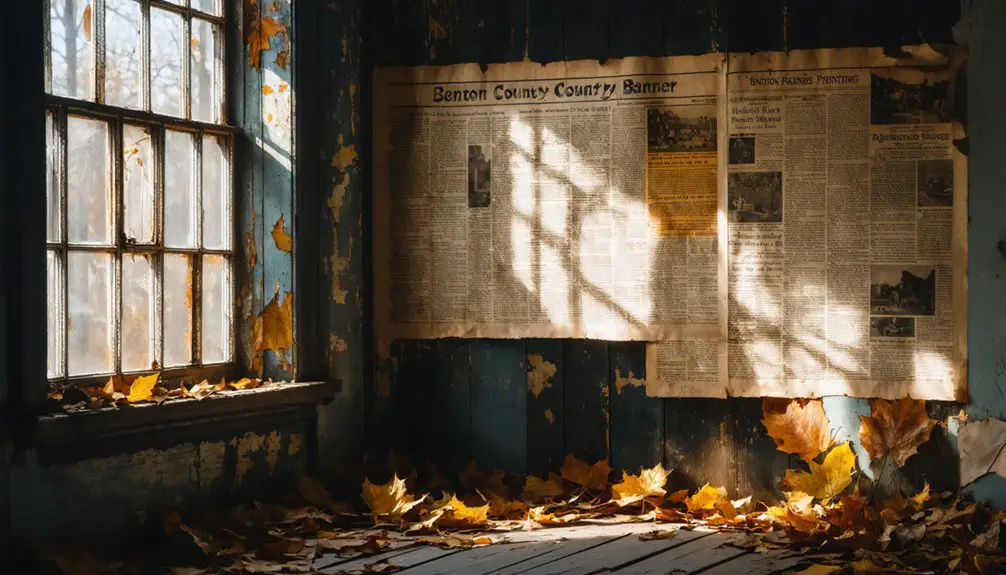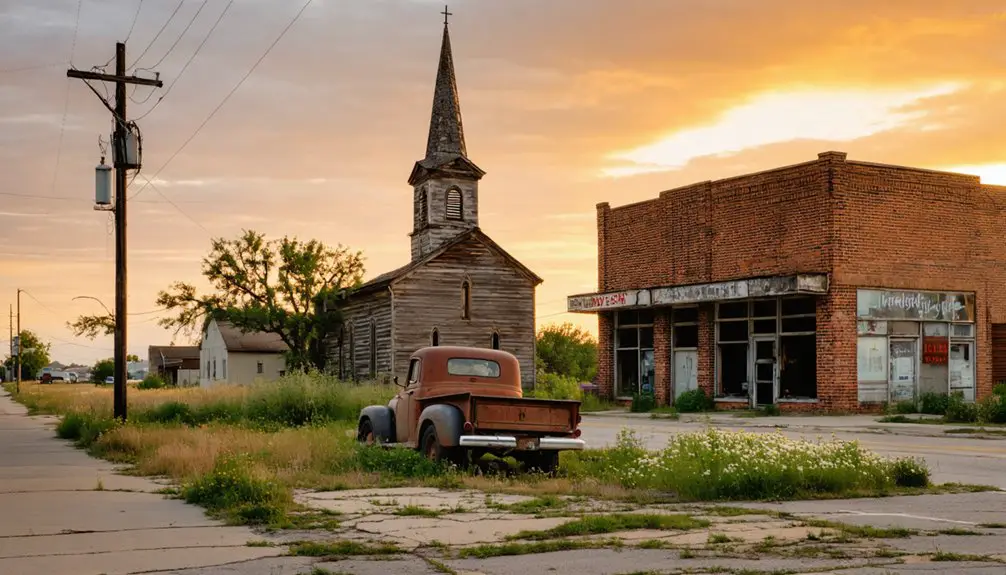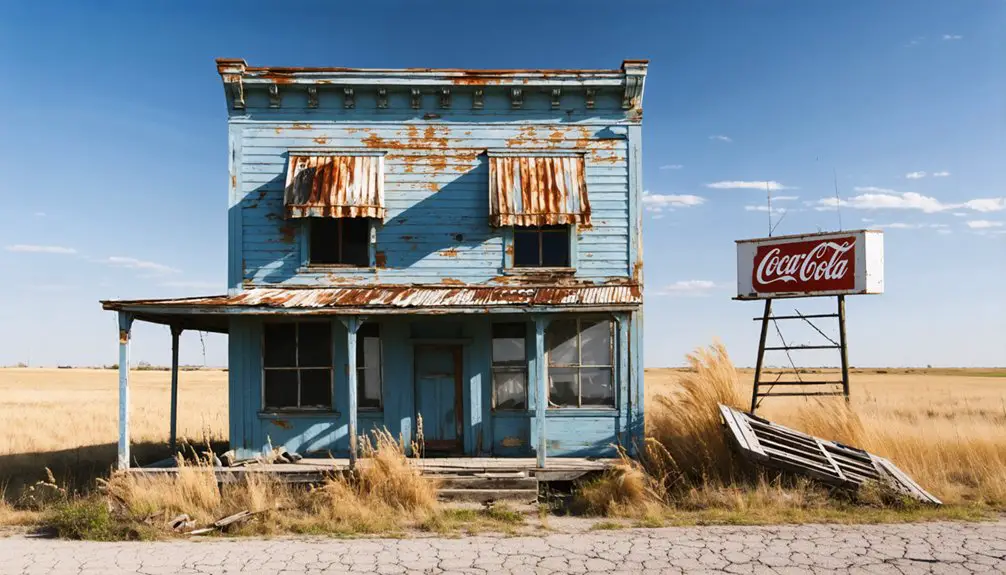You’ll find Benton’s ghost town story in Oklahoma’s No Man’s Land, where it thrived from 1886 to the early 1900s. The settlement peaked with nearly 1,000 residents, boasting essential businesses, two saloons, and the influential Benton County Banner newspaper. Despite its vision of becoming a county seat, Benton couldn’t survive the extinction of buffalo trading, lack of railroad connections, and competition from nearby Beaver City. Its abandoned remains hold fascinating tales of frontier life and vigilante justice.
Key Takeaways
- Benton flourished between 1886-1890 with up to 1,000 residents, featuring essential businesses like stores, hotels, and saloons near Beaver River.
- The town served as a self-governing community in No Man’s Land, relying on vigilance committees before Oklahoma’s territorial incorporation.
- The Benton County Banner newspaper established in 1886 promoted the settlement as the “Gem City” and documented daily life.
- Economic decline began when buffalo hunting ceased, nearby Beaver City grew, and the town lacked crucial railroad connections.
- By 1890, Benton’s isolation and changing territorial status led to its abandonment, transforming it into a ghost town.
The Rise of a Frontier Settlement
When pioneers established Benton’s post office in 1886 near the Beaver River, they laid the foundation for what would become one of No Man’s Land’s most promising frontier settlements.
You’ll find that Benton history reflects the untamed spirit of the Oklahoma Panhandle, where the town quickly grew to support between 500 and 1,000 residents at its peak.
Frontier life in Benton centered around essential businesses that sprang up to serve the community.
Two man-made wells supplied water to the bustling town, which boasted a general store, drugstore, hotel, livery stable, and two saloons.
The settlement’s strategic location attracted buffalo hunters, traders, and even notorious outlaws.
Most residents lived in sod homes with wooden floors and window sills, embodying the resourcefulness of frontier settlers.
The town’s peaceful Indian relations contributed significantly to its early development and trade.
Modern researchers rely on internal links to access historical records about Benton’s development.
Life in No Man’s Land
While Benton thrived as a settlement, its existence within No Man’s Land created unique challenges for residents between 1885 and 1890.
You’d have found yourself in a region where self governance challenges shaped daily life – no formal government meant relying on vigilance committees to maintain order. If you claimed land, you couldn’t legally own it until 1890, forcing you to defend your property through informal means.
In this untamed territory, you’d have witnessed vigilante justice dealing with jumpers and outlaws through banishment, shooting, or hanging. The first organized effort to protect land claims came when settlers established a Claimants Board in 1886.
Though poverty was widespread, you’d have joined other settlers in making the best of it, participating in the Cimarron Territory Provisional Government’s attempts to establish law and order through elected officials and newly created counties. By 1890, thirty post offices had been established across the eastern half of the strip, helping connect the scattered communities.
A Vision of Becoming County Seat
As Benton’s influence grew in No Man’s Land during the late 1880s, its leaders launched an ambitious campaign to establish the town as the seat of the proposed Benton County within Cimarron Territory.
Ambitious frontier leaders in Benton set their sights on transforming their No Man’s Land settlement into a prestigious county seat.
The Benton County Banner newspaper championed these aspirations, dubbing the settlement the “Gem City of the Neutral Strip” while highlighting its prime central location.
You’d have found a bustling frontier town equipped with hotels, saloons, and various merchants – all the trappings needed for county governance.
Similar to how Benton County in Arkansas experienced racial demographic shifts after the Civil War, many Black citizens left seeking better opportunities elsewhere.
Local leaders viewed Benton’s cultural and commercial prominence as natural stepping stones to political authority. Similar to how naming conventions changed in other U.S. territories, the proposed county name reflected local ambitions and regional development.
However, their dreams of establishing structured county government were cut short when Oklahoma Territory absorbed No Man’s Land in 1890, effectively ending Benton’s bid for county seat status.
Early Business and Commerce
The commercial landscape of 1880s Benton reflected the typical needs of a frontier settlement with aspirations for growth.
Much like the nearby mining camp Hattonville that would later become Commerce, the area attracted those seeking economic opportunities.
You’d find several business partnerships operating essential services: a general store, drugstore, hotel, and two saloons that formed the heart of the town’s transient economy.
A blacksmith shop served the practical needs of both residents and travelers.
This economic development pattern mirrored what would later happen in Commerce, which saw two banks and theaters by 1918.
Social Hub of the Neutral Strip
You’ll find Benton’s vibrant social scene centered around its two bustling saloons, which drew cowboys, settlers, and travelers seeking entertainment and camaraderie in the lawless Neutral Strip.
In 1886, residents established self-governing committees to maintain order during the formation of Cimarron Territory.
The town’s hotel hosted cultural gatherings that brought people together from across No Man’s Land, establishing Benton as the “Gem City” of the region.
Through the pages of the Benton County Banner, you can trace the pulse of frontier social life, from community events to territorial politics that shaped this distinctive Oklahoma settlement.
Local vigilante committees maintained order and justice in the town, ensuring the safety of residents and visitors during the period of limited governmental oversight.
Saloons Draw Frontier Life
Frontier saloons transformed Benton into a vibrant social hub within Oklahoma’s notorious Neutral Strip, with two prominent establishments drawing cowboys, travelers, and locals alike.
The saloon culture fostered economic drivers alongside hotels, general stores, and blacksmith shops, creating a bustling commercial nucleus in an otherwise isolated frontier.
You’ll find these establishments served multiple purposes in Benton’s development:
- Meeting grounds for essential business transactions and news exchange
- Social centers hosting events that shaped community identity
- Economic catalysts drawing visitors from neighboring states
- Safe havens offering release from frontier hardships
The strategic location of Benton’s saloons on the edge of “No Man’s Land” made them key destinations for those seeking refreshment, entertainment, and social connection in a region defined by its lawless reputation.
Hotels Host Cultural Events
During Benton’s heyday, grand hotels emerged as vibrant cultural epicenters within Oklahoma’s Neutral Strip, where diverse populations converged for social gatherings, performances, and political discourse.
You’d find these establishments bustling with activity, their spacious ballrooms and parlors hosting everything from theatrical shows to Native American craft fairs. The hotels’ architectural design, featuring wide verandas and communal dining areas, encouraged social interaction between settlers, traders, and indigenous peoples.
These cultural performances and community gatherings weren’t just entertainment – they served as economic drivers for the frontier town. In the sometimes lawless strip, hotels provided safe spaces for cultural exchange and political meetings.
Through seasonal dances, annual balls, and community feasts, these establishments fostered social cohesion and helped stabilize the volatile frontier environment.
Newspaper Chronicles Social Scene
The Benton County Banner, established in 1886 under publisher J.M. McCoy, served as the vibrant social heartbeat of the Neutral Strip.
You’ll discover how this newspaper shaped Benton’s identity as the “Gem City,” chronicling the town’s evolution through its coverage of social gatherings and cultural reflections.
The Banner’s influence on local life was profound, as evidenced by:
- Daily reports of saloon activities and hotel events that drew settlers from across the territory
- Publication of essential community announcements, from land claims to civic meetings
- Coverage of dances, social functions, and cultural happenings that united the diverse population
- Regular updates on business transactions and personal news that kept residents connected
Through McCoy’s leadership, the Banner transformed from a frontier news source into a sophisticated platform that legitimized Benton’s aspirations as a county seat.
The Benton County Banner Legacy

You’ll find evidence of Benton’s frontier spirit through its newspaper, the Benton County Banner, which chronicled daily life from 1886 to 1890 while advocating for the town’s position as county seat.
The Banner’s political voice shaped local identity, promoting slogans like “Benton, Gem City of the Neutral Strip” and championing the formation of Cimarron Territory.
Though few physical copies remain today, the newspaper’s legacy offers rare documentation of No Man’s Land‘s social development and territorial ambitions during Oklahoma’s pre-statehood period.
Frontier Press Chronicles
Nestled within Oklahoma Territory’s rich journalistic history, Benton County Banner emerged as an essential frontier newspaper that chronicled the transformation of Benton from a bustling settlement to an eventual ghost town.
The paper’s frontier journalism played a crucial role in documenting the community’s evolution while preserving its historical significance for future generations.
You’ll find these key aspects of the Banner’s chronicles:
- Documentation of settlement patterns, tribal affairs, and land disputes
- Coverage of economic activities including agriculture and cattle ranching
- Reports on territorial governance and legal developments
- Detailed records of social life, from school openings to church activities
Today, the Banner’s legacy lives on through preservation efforts by the Oklahoma Historical Society and university archives, offering valuable insights into frontier life and community dynamics.
Political Voice Preserved
Political influence radiated from the pages of Benton County Banner, established in 1886 by publisher J.M. McCoy.
You’ll find this newspaper was more than just a source of local news – it served as the driving force behind Benton’s political aspirations during Oklahoma’s territorial period. Through powerful editorials and community engagement, the Banner championed Benton’s bid to become the county seat of the proposed Cimarron Territory.
The paper’s political advocacy reflected the town’s ambitions, with detailed coverage of elections, governance initiatives, and regional developments.
As an indication of its historical significance, you can now access digitized archives dating back to 1889, preserving the political voice of what was once known as the “Gem City of the Neutral Strip” but has since become a ghost town.
From Boom to Abandonment
Despite its promising start as a bustling frontier settlement, Benton’s journey from boom to abandonment reflects the harsh realities of Oklahoma’s territorial era.
You’ll find its cultural significance deeply rooted in the wild west, where buffalo hunters, traders, and outlaws shaped the town’s character. The economic shifts that led to its downfall were swift and unforgiving.
Here’s what sealed Benton’s fate:
- The buffalo’s near extinction by 1880 eliminated a critical economic lifeline
- Incorporation of the Panhandle into Oklahoma Territory diminished its “No Man’s Land” appeal
- Nearby Beaver City’s growth drew away commerce and population
- Lack of railroad connections left the town isolated from essential trade routes
Today, where 500 to 1,000 residents once lived, you’ll find only empty prairie, marking another chapter in Oklahoma’s ghost town legacy.
Preserving the Memory of Benton

While the physical remnants of Benton have largely vanished from Oklahoma’s landscape, dedicated preservation efforts guarantee its memory endures through multiple channels.
You’ll find Benton’s story carefully documented in authoritative works like Morris’s “Ghost Towns of Oklahoma” and Schmidt’s recent research, ensuring ghost town narratives remain accessible to future generations.
Memory preservation continues through local heritage festivals, museum exhibits, and oral histories shared by descendant families.
Digital technologies now complement traditional documentation, with drone photography and 3D mapping capturing what remains of the site.
You can explore Benton’s history through online databases, interactive apps, and educational programs that bring the ghost town’s past to life.
Local historical societies work to protect the site, marking its significance while managing environmental challenges and preventing unauthorized access.
Frequently Asked Questions
What Happened to the Residents of Benton After the Town Was Abandoned?
You’ll find that residents’ migration led them primarily to Beaver City, where they sought new economic opportunities. Many settlers dispersed throughout Oklahoma Territory, adapting to life after abandonment of their former home.
Were There Any Notable Crimes or Shootouts Recorded in Benton?
You won’t find specific documented shootout incidents or criminal history for Benton itself, though the town’s location in No Man’s Land suggests it likely experienced similar lawlessness to neighboring communities.
What Was the Peak Population of Benton During Its Prime Years?
While Benton’s history shows fascinating population growth during its frontier days, you’ll find that historical records indicate the town reached its peak population of between 500 and 1,000 residents in its prime.
Did Native American Tribes Have Any Significant Interactions With Benton’s Community?
You’ll find that Native American tribes interacted with Benton through cultural exchange and historical treaties, as the town sat on former Indian Territory where tribes maintained hunting grounds and trading relationships.
How Did the Weather and Natural Disasters Affect Benton’s Development?
You’ll find that severe weather impacts like harsh winters, intense heat, and strong winds undermined Benton’s buildings and agriculture, while limited rainfall and water scarcity complicated disaster recovery and long-term sustainability.
References
- https://en.wikipedia.org/wiki/Benton
- https://www.youtube.com/watch?v=aeAXyEw70io
- https://en.wikipedia.org/wiki/List_of_ghost_towns_in_Oklahoma
- https://okcfox.com/news/local/oklahomas-secret-past-ghost-towns-of-oklahoma
- https://www.ghosttowns.com/states/ok/benton.html
- http://genealogytrails.com/oka/nomansland.html
- https://www.youtube.com/watch?v=LUbwVR0z0nA
- https://www.okhistory.org/publications/enc/entry?entry=NO001
- https://www.bradycarlson.com/oklahomas-panhandle-was-once-known-as-no-mans-land-cool-weird-awesome-1127/
- https://en.wikipedia.org/wiki/Oklahoma_panhandle



